
* The B-17 began life as a mid-1930s design that was advanced for its time, and provided an excellent basis for further development. However, when war finally came, the Flying Fortress would prove painfully inadequate, and suffer through a difficult learning curve until it finally came into its own as an effective weapon.
* William Boeing had gone into business building seaplanes in Seattle, Washington, in 1916. In the decades after World War I, the Boeing Company became successful selling aircraft to the US military and commercial airlines. In those decades, the US military returned to the weak state that had been its tradition in peacetime years, and the arrival of the Great Depression did nothing to improve its health. The military leadership tended to be conservative, and US Army Air Corps (USAAC) visionaries who believed in air power received uncertain support. However, commercial aircraft development was leading to great advances in aircraft design that would benefit the military.
In 1930, the Boeing Company introduced a single-engine, all-metal, low-wing monoplane named the "Model 200 Monomail" that featured the new innovation of retractable landing gear. The Monomail led to the twin-engine "Model 215 / YB-9" bomber, which lost an Air Corps competition against the Martin B-10 and did not enter production. The YB-9 in turn led to the sleek twin-engine "Model 247" airliner. All these aircraft were powered by air-cooled Pratt & Whitney (P&W) radial engines and gave Boeing experience in building advanced, strong aircraft from aluminum alloy.
The Model 247 in particular defined ideas that Boeing would exploit in the future. It is generally regarded as the first modern airliner, an all-metal, low-wing monoplane with retractable landing gear; twin P&W Wasp S1D1 engines with 410 kW (550 HP) each and driving three-bladed fixed-pitch propellers; a crew of three, including a pilot, copilot, and stewardess; and seating for ten passengers. It also featured pneumatic de-icer boots in the wing leading edge, which were inflated to knock ice off the wing.
Initial flight of the Model 247 was on 8 February 1933. A total of 59 was built for United Air Lines, plus two for the German LuftHansa airline. A single "Model 247A" was built as well, featuring P&W Twin Wasp Junior engines with 465 kW (625 HP) each, and provided long service to the United Aircraft Corporation as an executive transport. Boeing also built 13 "Model 247Ds", which featured a number of refinements, including P&W Wasp 51H1-G radials with 375 kW (500 HP), installed in modified cowlings and driving three-bladed variable-pitch propellers; a significant increase in fuel capacity; fabric-skinned rudder and elevators; and replacement of antique-looking forward-sloped cockpit windscreen of the Model 247 / 247A with a modern backward-sloped windscreen.
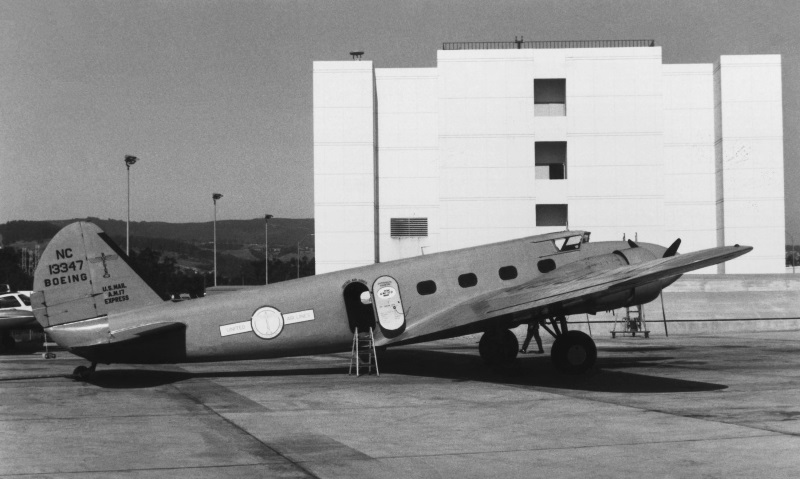
The Model 247D offered improved speed, about half again as much range, and better looks than the Model 247 / 247A, and most of the older machines were brought up to 247D standard. One 247D was fitted with machine guns as an armed VIP transport for a Chinese warlord and redesignated "Model 247Y".
___________________________________________________________________
BOEING MODEL 247D:
___________________________________________________________________
wingspan:
22.56 meters (74 feet)
wing area:
77.68 sq_meters (836.13 sq_feet)
length:
15.72 meters (51 feet 7 inches)
height:
3.6 meters (12 feet 2 inches)
empty weight:
4,150 kilograms (9,150 pounds)
MTO weight:
6,190 kilograms (13,650 pounds)
cruise speed:
305 KPH (190 MPH / 165 KT)
service ceiling:
7,740 meters (22,400 feet)
range:
1,200 kilometers (745 MI / 650 NMI)
___________________________________________________________________
27 247Ds were impressed into US military service during World War II as "C-73s", and a number were also flown by the Royal Canadian Air Force during the conflict. At least four have survived as museum displays.
* In the meantime, Boeing was also working on more warlike flying machines. In February 1934, the USAAC issued a request for an experimental aircraft with the designation "Experimental Bomber Long-Range 1 (XBLR-1)". The requirement specified an aircraft capable of carrying a 900-kilogram (1 US ton) bomb load over 8,050 kilometers (5,000 miles). In keeping with America's basically isolationist policies of the time, the aircraft was intended as an experimental demonstrator for a long-range bomber that could protect the US from foreign fleets, and help guard Hawaii and the Philippines. Since money was tight, only one aircraft was funded.
Boeing President Claire Egtvedt was eager to push the state of the art in large-aircraft technology, and Boeing responded with a design called the "Model 294". The Air Corps accepted the Boeing proposal over a Martin offering in June 1934, giving the Boeing aircraft the designation "XB-15". It was the biggest aircraft built in the US to that time, much on the scale of the big propaganda planes built for the Soviet state by the Tupolev design bureau, but somewhat more elegant. The XB-15 was a sleek machine, made mostly of aluminum; was powered by four 745-kW (1,000-HP) Pratt & Whitney Twin Wasp engines; and had very large fuel capacity.
The XB-15 was to have a crew of ten. It was fitted with streamlined gun blisters in the style of the time and was to be armed with six machine guns, though pictures of the machine do not show it to have actually been fitted with defensive armament. The big bomber had sleeping quarters and a galley, as well as a thick, broad wing that, so the story goes, contained tunnels into which a flight engineer could crawl to tinker with the engines.
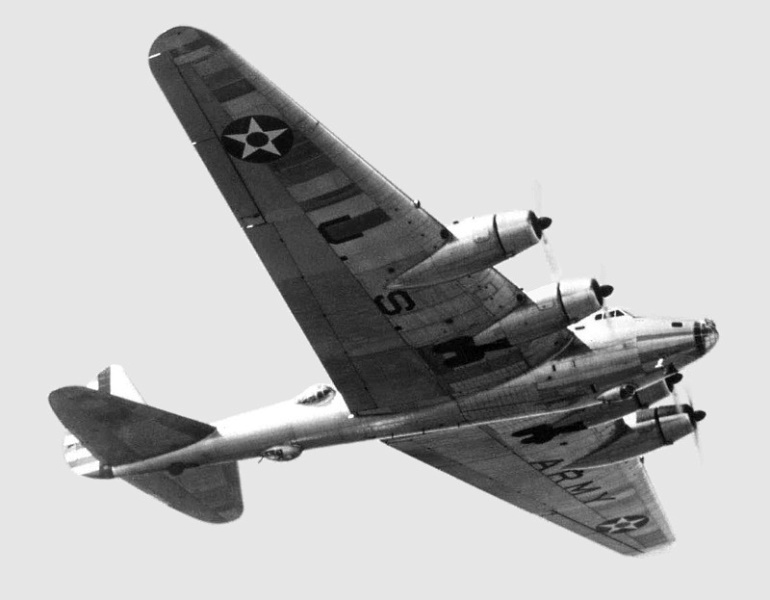
The sole XB-15 finally performed its first flight on 15 October 1937. Since it had been designed for a new 1,500 kW (2,000 HP) radial engine under development by Allison that would never really materialize, the XB-15 proved to be very underpowered, with a top speed of only 315 KPH (195 MPH). In the war years, it was fitted with cargo doors and used as a freight hauler, under the designation "XC-105".
___________________________________________________________________
BOEING XB-15:
___________________________________________________________________
wingspan:
45.42 meters (149 feet)
wing area:
258.26 sq_meters (2,780 sq_feet)
length:
26.80 meters (87 feet 11 inches)
height:
5.49 meters (18 feet)
empty weight:
17,105 kilograms (37,710 pounds)
MTO weight:
41,730 kilograms (92,000 pounds)
max speed at altitude:
315 KPH (195 MPH / 170 KT)
service ceiling:
5,760 meters (18,900 feet)
range:
8,255 kilometers (5,130 MI / 4,460 NMI)
___________________________________________________________________
Only one XB-15 was built, but the design proved influential. Its wing was reused in the Boeing Model 314 Clipper flying boat; much more significantly, it led to a new bomber that would be one of the most famous in aviation history.
BACK_TO_TOP* Even while the XB-15 was moving off the drawing board, both the Air Corps and Boeing were looking for a more practical bomber to replace the Martin B-10s then in service. In August 1934, the Air Corps issued a request for a multi-engined bomber aircraft that could carry a "useful bombload" with a cruising speed of 355 KPH (220 MPH) at an altitude of 3 kilometers (10,000 feet) for ten hours. Top speed was to be 400 KPH (250 MPH).
The potential production quantity was a hundred aircraft, and Boeing officials were eager for the business. The company quickly responded with a design with the designation "Model 299". The Model 299 had four engines instead of the two implied in the request, but the Air Corps assured Boeing that wasn't a problem. The USAAC approved the construction of a prototype of the Model 299 on 26 September 1934. Boeing allocated initial funding of $275,000 USD, but this sum would double before the prototype flew. The design team was led by E. Gifford Emery, along with Edward C. Wells. The design they came up with looked something between a scaled-down version of the XB-15, then in design, and a scaled-up, four-engine version of the Model 247.
The Model 299 was a mid-wing monoplane of aluminum construction, powered by Pratt & Whitney R-1690 Hornet single-row nine-cylinder radial engines. The engines could each produce 560 kW (750 HP) at 2,135 meters (7,000 feet) and drove three-bladed Hamilton Standard propellers with a diameter of 3.5 meters (11 feet 6 inches). The aircraft had a wingspan of 31.6 meters (103 feet 9 inches) and a length of 20.95 meters (68 feet 9 inches). The nose was glazed to give the bombardier a good view. There was a nock under the nose where the bombsight was placed, as well as a bubble on top of the nose glass where a machine gun could be mounted.
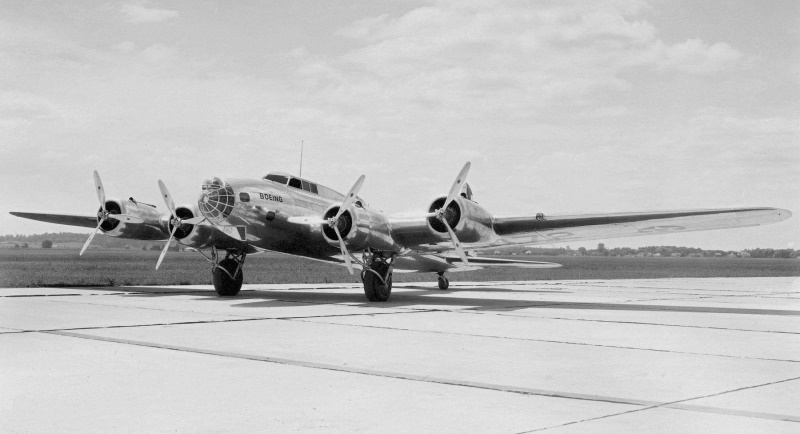
The pilot and copilot sat side-by-side, each within reach of a clever new central throttle arrangement that allowed them to control all four engines with one hand. There was a bomb bay behind the cockpit, with twin vertical bomb racks accommodating up to 2,177 kilograms (4,800 pounds) of bombs. There was a flight engineer / radioman position behind the bomb bay, connected to the cockpit by a narrow catwalk through the bomb bay. There was a machine-gun blister above the radioman's position, with a tub on the belly a little further to the rear for another machine gun, and then twin blisters on either side of the fuselage, to be each fitted with a single machine gun. Either 7.62-millimeter or 12.7-millimeter (0.30 / 0.50 caliber) Browning machine guns could be mounted, giving the Model 299 defensive armament of five machine guns.
The aircraft was of taildragger configuration, with a semi-retractable tailwheel. The main gear retracted to a half-recessed position in the inner engine nacelles.
* The Model 299 was publicly rolled out at Boeing field in Seattle on 17 July 1935. The new aircraft was big and impressive, with a gleaming art-deco THRILLING WONDER STORIES pulp-fiction look to it. Reporter Richard Williams of the SEATTLE DAILY TIMES was inspired to call it a "flying fortress". Boeing public relations men liked the name so much that they adopted it and registered it as the aircraft's official name. First flight was on 28 July, and on 20 August 1935 the aircraft flew from Seattle to Wright Field near Dayton for Air Corps evaluation. The flight was made in 9 hours 3 minutes at an average speed of 375 KPH (235 MPH). That was much faster than its rivals in the Air Corps competition, the Douglas DB-1 and the Martin 146. However, the Model 299 cost almost $200,000 USD, more than twice as much as either of its two competitors.
The evaluation program went well up until very near the end. On 30 October 1935, the Model 299 crashed on takeoff. The pilot, Air Corps Major Ployer Hill, and Boeing test pilot Leslie Tower were killed; there were two survivors. The accident was not due to any inherent fault in the design of the aircraft. The Model 299 had a set of control surface locks that could be set from the cockpit to prevent wind damage to the control surfaces while the aircraft was parked. Hill had failed to release this control during take-off and Tower had failed to notice the error. Unfortunately, the ruined Model 299 could not finish the Air Corps evaluation, and the Army selected the Douglas DB-1 instead. The DB-1 was a derivative of the Douglas DC-2 commercial transport, being designated the B-18 in service. 350 were built, though the design was effectively obsolete within a few years.
Despite the Model 299's high cost and the accident, the Air Corps thought the design had obvious merit, and so on 17 January 1936 the Army ordered 13 flying Model 299s and a static test airframe from Boeing for the sum of $3,823,807 USD -- funds that the overstretched company badly needed to stay afloat. The 13 aircraft were to be designated "YB-17".
BACK_TO_TOP* In December 1936, the Air Corps changed the designation YB-17 to the odd designation "Y1B-17" to indicate that these aircraft were specially funded. In practice, the aircraft were still referred to as YB-17s in most documentation.
The first Y1B-17 was delivered to the Air Corps in January 1937, with the last of the 13 delivered that August. The Y1B-17 looked very much like the Model 299 prototype, but there were significant differences. The Model 299's main wheels had been mounted on a two-sided strut assembly, which made them difficult to swap out, while the Y1B-17 featured a one-sided strut that allowed the tires to be changed more easily. Rubber pneumatic de-icer boots were installed on the leading edge of the wing of the Y1B-17. The landing flaps had been covered with aluminum on the Model 299, but were fabric-covered on the Y1B-17.
The most important change was a switch from Pratt & Whitney Hornet engines to Wright R-1820 Cyclone engines. The Cyclone was, like the Hornet, a nine-cylinder single-row radial engine, but had more growth potential. The R-1820-39 Cyclone provided 710 kW (950 HP) for take-off, about 25% more than the Hornet.
* The Air Corps was engaged in an internal struggle for operational independence within the Army. Many senior Army officers believed that the only role of air power was to support ground forces, and there were those in government and particularly in the Navy who supported that concept. The Navy had traditionally been America's means of projecting military power overseas, and the admirals did not want Army aircraft intruding into their domain. Many Air Corps officers, in contrast, felt that air power could play an important strategic role in its own right, and the Flying Fortress figured prominently in their thinking. Twelve of the new bombers were sent to a special bombing unit, the 2nd Bombardment Group at Langley Field, Virginia, under the direct control of General Headquarters Air Force.
These Fortresses were sent out on a number of publicity exercises. One Y1B-17 flew coast to coast and back again in early 1938, breaking transcontinental speed records. In February 1938, six Fortresses made a goodwill trip to Buenos Aires, Argentina, stopping in Lima, Peru, on the way down and in Panama on the way back. A few days later, seven of the bombers made a similar trip to Rio de Janeiro, Brazil. Formations of Fortresses overflew major American cities, including overflights of New York City in May 1937 and early 1938.
One of these publicity stunts led to trouble with the Navy. In May 1938, three Fortresses flew 1,125 kilometers (700 miles) out into the Atlantic to find the Italian ocean liner REX, where one dropped a message on its deck. The primary navigator on this mission was a young Air Corps lieutenant named Curtis LeMay, who would be an influential player in the growth of American strategic air power. The interception of the REX infuriated Navy brass; an order quickly came down from the Army high command restricting Army operations to within 160 kilometers (100 miles) of the US coast. The incident also led to increased political pressure in Washington to suppress the strategic bombing concept, though that would subside after the Munich crisis in September 1938.
* Despite the frictions, the USAAC had been refining their strategic bombing ideas anyway. While the fourteenth Y1B-17 was only built for static test, it was upgraded to flight status and its engines were fitted with exhaust-driven turbochargers. This aircraft was designated the "Y1B-17A".
The turbochargers proved troublesome, and though the Y1B-17A was scheduled to fly in late 1937, it did not actually take to the air until April 1938. Flight tests proved troublesome as well. The turbochargers were mounted above the engine nacelles, and their exhaust disrupted the airflow over the wing, leading to vibration. Quick fixes didn't work, so Boeing engineers decided to relocate the turbochargers to the bottom of the nacelles. This rework was done at a company expense of almost $100,000 USD, since the penny-pinching Air Corps would not cover the cost. Performing this modification and getting it to work right took until spring 1939, but the results were impressive. The service ceiling increased from 9,450 meters (31,000 feet) to 11,580 meters (38,000 feet) and the maximum speed increased from 410 KPH (255 MPH) to 500 KPH (310 MPH).
By that time, new Fortresses were already rolling down the production line. The Air Corps had signed a contract with Boeing in late 1937 for ten improved Fortresses with turbochargers, to be designated "B-17B", and orders for 29 more B-17Bs followed.
BACK_TO_TOP* The first flight of the B-17B was on 27 June 1939, with deliveries of the 39 aircraft beginning in July 1939 and ending in March 1940. These aircraft were used to equip two bombardment groups, one on the Atlantic coast and one on the Pacific coast, making the B-17B the first Fortress to equip operational USAAC units. The most visible differences from the Y1B-17A were a larger tailfin, plus a new nose that eliminated the gunner's bubble and the ugly nock underneath the nose. The new nose had a flat panel for the bombsight, which was moved forward, and a socket in the Plexiglas that could accommodate a 7.62-millimeter machine gun.
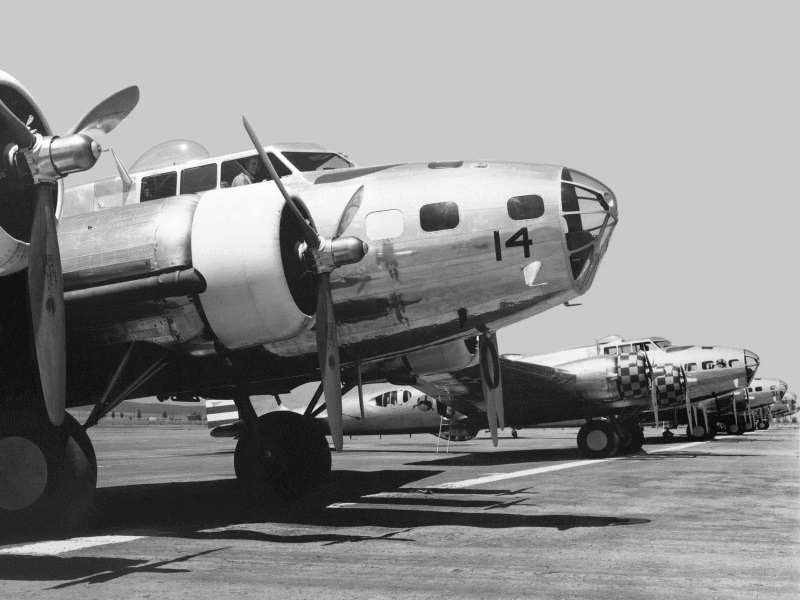
The old nose-gun arrangement hadn't proven very practical. British Air Commodore Arthur Harris, later in charge of the Royal Air Force's (RAF) Bomber Command, visited the US in 1938, and on inspecting a Y1B-17 suggested that the nose layout was "more appropriately located in an amusement park than in a war aeroplane." Harris was in general highly critical of the defensive armament of the Fortress. While it may have seemed heavily armed in 1935, times had changed, and the combat survivability of the B-17 was beginning to worry the Air Corps and Boeing.
The B-17B incorporated a number of other small refinements. The navigator's position was moved from behind the pilots to the nose, where he would have better visibility. The fabric flaps reverted to aluminum, and the brakes were changed from pneumatic to hydraulic operation. The B-17B was also fitted with the top-secret Norden bombsight, which was the subject of radio-melodrama security measures. The bombsight was installed under wraps before the beginning of a mission and then taken away in the same way after landing, always under the supervision of an armed guard.
* Even before the first flight of the B-17B, the Air Corps had requested a still better Fortress, and in September 1939 ordered 38 "B-17Cs". The B-17C emphasized improvements in combat survivability. The teardrop gun blisters on the sides of the fuselage were replaced by flush-mounted windows. The blisters had limited vertical gun traverse severely, while contributing to drag and interfering with airflow over the tailplane. The new windows were left teardrop-shaped to avoid major redesign of the rear fuselage.
The dorsal blister was also removed and replace with a flush sliding transparency. The ventral blister was replaced with a "tub", somewhat like that on the German Heinkel He 111, where the gunner could kneel and direct fire below and to the rear. Two additional socket holes were added in the nose to give the crew some flexibility in mounting the single 7.62-millimeter nose gun.
Armor protection was added, along with a crew oxygen system and an improved fuel-distribution scheme. The changes resulted in a significant increase in maximum weight, but the B-17C was also fitted with uprated Wright R-1820-65 Cyclone engines. The new engines could provide 895 kW (1,200 HP) at altitude, increasing the speed of the B-17 to 520 KPH at 7,620 meters (325 MPH at 25,000 feet). The first B-17C flew on 21 July 1940, and went into Air Corps service in August. The last of the 38 were delivered by the end of 1940.
War was raging in Europe, and the RAF was desperate for new combat aircraft. Following the passage of the Lend-Lease military assistance act in March 1941, an arrangement was made to provide the first 20 B-17Cs to the British. These aircraft were refitted with self-sealing fuel tanks, delaying the delivery of the first four aircraft to April 1941. The RAF gave them the designation of "Fortress I".
* The B-17C was almost the last of the breed. Boeing wasn't making money on the Fortress and wanted to charge the USAAC $205,000 USD, while the Air Corps insisted on a fixed price of $198,000. Air Corps General Carl Spaatz conducted intense negotiations with the company, and the two parties finally agreed to a price of $202,500 USD, with some features of the aircraft eliminated.
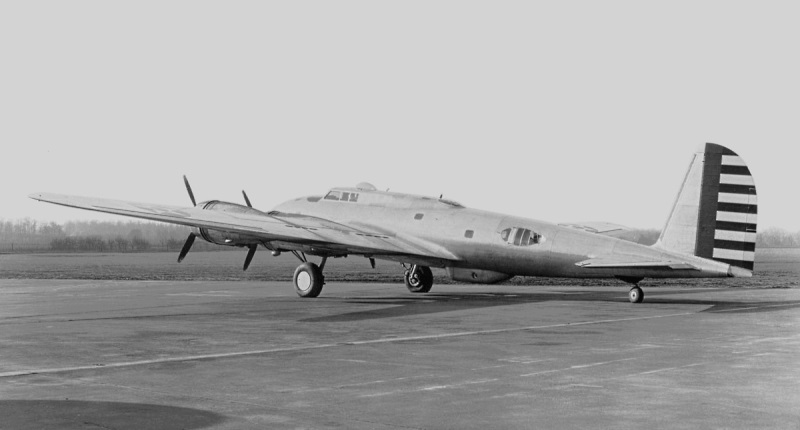
The Air Corps wanted 42 more B-17Cs, but as the new batch materialized it featured enough changes to be given the new designation of "B-17D". This aircraft looked very much like a B-17C, but was fitted with two 12.7-millimeter guns each in the upper and lower gun positions, as well as improved armor and a large number of minor internal changes. The B-17Ds were delivered from February through April 1941. Some of the B-17Cs were updated to B-17D specification.
BACK_TO_TOP* The first Fortress I arrived in Britain on 14 April 1941, with the others in the batch arriving over the next few months. They were fitted with radios and other gear to bring them up to RAF standards, and crews were selected and trained for operations. The US still considered the Norden bombsight a top secret and had not given it to the British, so the Fortress Is were fitted with the comparable Sperry Mark 0-1. It was likely no drawback; the Norden company's real asset was good salesmen, not exceptional technology, and in hindsight, the Norden bombsight was greatly oversold.
The Fortress did not get off to a good start in RAF service. The USAAC considered high altitude to be 6,100 meters (20,000 feet). In order to avoid interception, the RAF proposed to operate the Fortress I at least half again as high as that. Finding crewmen fit enough for such duty was difficult, while the extreme cold temperatures at that altitude froze up windows and guns and played hell with the Cyclone engines. One of the Fortresses was lost in June when the pilot tried to fly it over a thunderhead and went inside the boiling clouds instead. The bomber was hammered by hail, iced over, went into a dive, and was torn apart. There was only one survivor.
Despite the problems, the Fortress I was judged ready for combat that summer. That was too optimistic. The first Fortress combat mission took place on 8 July 1941, when three Fortresses were sent to bomb the naval barracks in Wilhelmshaven. The mission was a fiasco, with one bomber turning back and the other two scoring no hits. The bombers had been rendered ineffective by frozen equipment. Luftwaffe Messerschmitt Bf 109 fighters attempted to intercept them, but the German pilots were almost as plagued by the high altitude and cold as were the British, and accomplished nothing.
Three Fortresses were dispatched to bomb Berlin on 23 July, but the target was clouded over and the bombers flew back home without making an attack. The pattern of ineffectual RAF activities with the Fortress I had now been set.
To improve the bomber's effectiveness, the RAF decided to reduce the operating altitude to Air Corps practice to provide better bombing accuracy and reduce the mechanical problems encountered in extreme high altitude operation. This naturally meant that encounters between the bombers and Luftwaffe interceptors became more earnest. One Fortress had it out with three Bf 109s at 6,700 meters (22,000 feet) on 2 August 1941, shooting down one and damaging another badly enough to cause it to force-land. Unfortunately, that was apparently little more than luck, since that same Fortress was jumped by seven Bf-109s over Brest on 16 August. The RAF pilot escaped by going into a shallow dive into cloud, but two men were killed and two more wounded. He crash-landed the Fortress, which was then consumed by fire.
On 8 September, four Fortresses attempted to bomb the German pocket battleship ADMIRAL SCHEER, docked in Oslo. One of the bombers was shot down, another disappeared, and a third was so badly shot up that it had to be written off after returning to base. The Fortress I was withdrawn from combat operations at the end of September 1941. A few were sent to Egypt, where they also proved to be no great asset, not being really up to desert operational conditions.
* The RAF's high-altitude bombing campaign with the Fortress had proven a failure. Although improvements were made during the course of operations, the Fortress wasn't really technically ready for operational service; its defensive armament had proven inadequate; and high-altitude bombing had been inaccurate. The bomb load of the Fortress was also modest for an aircraft of its size, which would be the main weakness of the type through its entire career.
The strategic bombing advocates in the US Army Air Forces (USAAF, which superseded the Air Corps in June 1941) remained faithful to the Fortress. Many of the RAF crews had liked the tough aircraft, and to an extent it had been operated under conditions for which it had not been designed, by crewmen who were not well trained for such operations. USAAF Commanding General Henry H. "Hap" Arnold complained that "the British never gave the Fortress a chance." The British were not done with the Fortress, however -- though they would never really operate it as a bomber again.
BACK_TO_TOP* If the RAF's combat trials of the Fortress had not been fair, the experience had still demonstrated many deficiencies in the type, in particular the weakness of its defensive armament. Boeing and the USAAF were already working hard to improve the machine and begin production of the Fortress in serious quantity. By the summer of 1940, the threat of war between the Axis powers and America was becoming too obvious to ignore, and by the fall of that year the Air Corps had ordered 277 new Fortresses, to be designated "B-17E". Bigger orders were expected to follow.
The B-17E was a major redesign. The lack of a tail turret in the B-17D and its predecessors had been a significant flaw, because the easiest way for a fighter to destroy a bomber was to get on its tail and hammer away at it. Attacks from other quarters meant a quick pass and tricky deflection shooting. Contemporary RAF bombers had a tail turret to discourage tail attacks, but the Fortress was highly vulnerable to attack from the rear.
The B-17E was given a new rear fuselage from the radio operator's position back to the tail, where a new gun position was added. Fitting a full turret was impossible given the narrow real fuselage, so the gun position was in the form of a "stinger" with twin 12.7-millimeter guns with a limited traverse. The new rear fuselage was about 1.8 meters (6 feet) longer. The tail gunner knelt behind glass windows and manually aimed the guns. The tail assembly was entirely new and bigger, featuring in particular a tall tailfin. For this reason, the B-17E and its descendants were referred to as "big-assed" -- or more politely, "big-tail" -- Fortresses, while the B-17D and its ancestors were called "shark-tailed Fortresses".
The changes didn't stop there. Since the rear fuselage had to be redesigned anyway, the teardrop-shaped windows for the pedestal-mounted waist guns were changed to rectangular windows. A remote-controlled Bendix power turret was installed in the belly, with twin 12.7-millimeter guns controlled by a gunner lying prone and peering through a periscopic sight. The radioman retained the upward-firing 12.7-millimeter gun, but a new Sperry power turret with twin 12.7-millimeter guns was installed just behind the cockpit. The nose was lengthened, and provisions were made for mounting one or two 7.62-millimeter machine guns in the front Plexiglas. The nose gun fit was not very effective, but for the moment nobody could figure out a better way to put defensive armament into the cramped nose. Although the B-17E was heavier than the B-17D while being powered by the same engines, it was not much slower due to aerodynamic improvements in its design, with a maximum speed of 510 KPH (320 MPH).
The first B-17E rolled off the production line at the end of September 1941. Flight experience quickly showed that the remote-controlled belly turret was impractical. Trying to track an attacking fighter through a periscope was all but impossible; much worse, the gunner suffered from severe nausea and motion sickness. The answer was to replace the remote-control turret with a Sperry "ball" turret with the 113th B-17E. The gunner crawled into the ball turret after take-off and sat straddled by the two guns while aiming down between his legs. The ball turret could cover almost the entire lower hemisphere below the Fortress and could be directed accurately. However, it generally required a gunner of relatively small stature, and the gunner could not wear a parachute while he occupied it. Another disadvantage was that there was no room to store spent cartridges inside the turret, and the rain of cartridges from the ball turret could pose a hazard to other aircraft in formation flying.
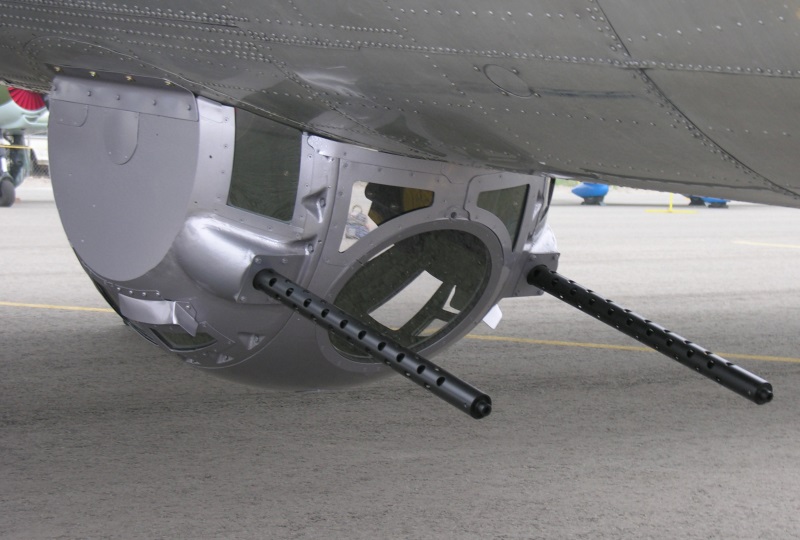
The new B-17E was dramatically different from its predecessors. The THRILLING WONDER STORIES look of the early Fortresses was gone. The B-17E was a serious weapon, and looked like one.
* When the Japanese Imperial Navy attacked the US Navy base at Pearl Harbor in Hawaii on 7 December 1941, B-17Cs and B-17Ds were in the line of fire. There were twelve Fortresses at Hickam Field on Oahu, with all destroyed in the raid. As bad luck would have it, another dozen Fortresses arrived during the raid; four of the newcomers were destroyed and the rest damaged. It was doubly bad luck, because a report from a radar station of a large formation of aircraft approaching Oahu was disregarded, the assumption being that it was a formation of Fortresses -- not, as it proved, Japanese fighters, dive bombers, and torpedo planes.
Clark Field in the Philippines was attacked shortly afterwards, and of the 35 Fortresses stationed there, 14 were destroyed. Fortunately, a squadron of this group had been operating at an airstrip to the south and escaped destruction. On 10 December, as the Japanese invasion force was unloading on the shores of Luzon, six B-17Ds dropped their bombs on them from high altitude. They did little damage, but did inspire a myth that helped support morale back home during the coming months of crushing defeats. A B-17 piloted by Lieutenant Colin Kelly JR was attacked by Japanese Zero fighters after the bomb raid. A lengthy and brutal fight followed. Kelly managed to keep the aircraft aloft long enough to let his crew bail out, but he died with his aircraft. He became one of the first heroes of the war, and the story was even inflated to claim that he had sunk a battleship.
On 14 December, a B-17D was bounced by 18 Zeroes and managed to hold them off until they were out of ammunition. The Fortress crash-landed, but it had proven for the first and definitely not the last time just how tough the Fortress was.
The Philippines were in Japanese hands by the end of 1941. The surviving Fortresses in the area were withdrawn to Darwin, Australia. B-17Es began to arrive from the States to reinforce them by mid-January 1942, and their improved armament came as a nasty surprise to Japanese fighter pilots who had already learned the Fortress was hard to shoot down. They found that the belly was a weak spot due to the ineffectual remote-control turret, only to learn otherwise when B-17Es with the Sperry ball turret showed up.
The Fortress was still engaged in an uphill struggle. About two-thirds of the Fortresses thrown into the battle in the early months of the war in the Pacific were lost, while the Japanese swept south into Java and threatened New Guinea and Australia. The shark-tailed Fortresses quickly disappeared from combat, since they had never been built in any quantity and were much less combat-effective than the B-17E. However, the parts of a number of these early Fortresses were thrown together to build a customized personal transport for General George Brett. This aircraft was more or less a B-17D without armament and with passenger conveniences. It was named THE SWOOSE, after a pop song with the title "Alexander the Swoose", concerning a bird that was half swan and half goose -- incidentally, such crosses do occur in nature. This aircraft is the only shark-tail B-17 that has survived; it is being restored by the USAF Museum in Dayton, Ohio.
The Japanese managed to reconstruct a single B-17D from the wreckage left in the Philippines, and captured two B-17Es in Java. These were sent to Japan for evaluation and to help train fighter pilots.
* 512 B-17Es were built. There were some field conversions of this type, the most significant being General Douglas MacArthur's personal transport, BATAAN, which was stripped of armament and fitted with 38 passenger seats along with every personal comfort. It was given the designation "XC-108". Another B-17E was converted to a cargo transport, with a large door on the left side, and designated "XC-108A".
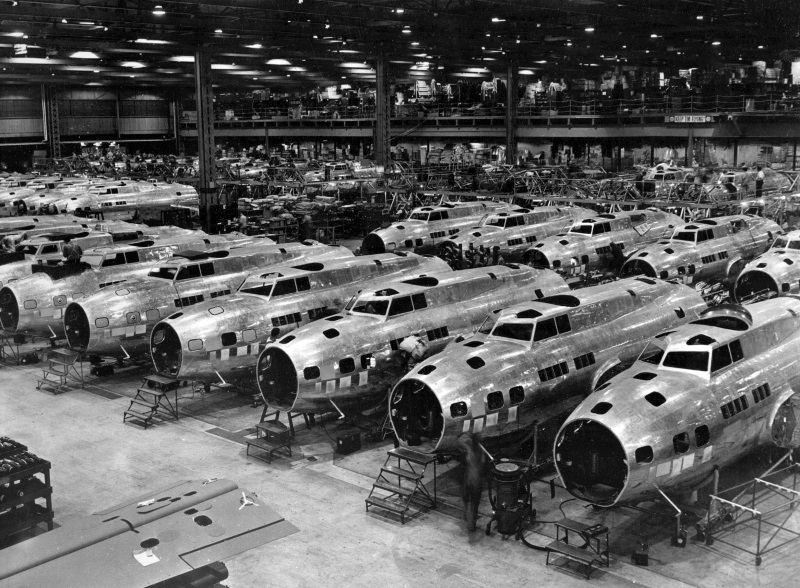
46 B-17Es were supplied to the RAF, which designated them the "Fortress IIA". The Fortress II, confusingly, was the designation given to the later B-17F in RAF service. The RAF had originally been promised 300 of the better B-17Fs, but USAAF requirements had forced a change in plans, and so a smaller batch of B-17Es were provided instead, resulting in the switched designations.
The RAF hadn't forgotten their bad experience with the Fortress I, and had mixed feelings about the new Fortresses as well. The RAF judged the B-17E's tail and belly turrets to be ineffectual; that was possibly unfair, since for most of the war the defensive armament of RAF bombers consisted of 7.7-millimeter (0.303-caliber) machine guns that lacked hitting power, and RAF bombers generally lacked belly armament, making them painfully vulnerable to attacks from below. However, the RAF also didn't much care for the B-17's unarguably small bombload. The British were no longer focusing on high-altitude daylight strategic bombing at the time in any case, and so the Fortress IIA was pressed into service with the RAF Coastal Command for ocean patrol, where its long range was a clear asset. It was designated "Fortress GR.II" in this role.
The RAF had the Lancaster for strategic bombing, and for many valid reasons felt that the Fortress was better suited to ocean patrol. The Coastal Command Fortresses were painted in splendid maritime livery of white with dark sea gray upper surfaces. One Fortress IIA was fitted with a 40-millimeter Vickers "S" gun in the nose for countering flak from surfaced U-boats. A gondola was built under the nose to accommodate the gunner. Test firings of the big gun in early 1944 demonstrated unacceptable shock and vibration, and the idea was abandoned.
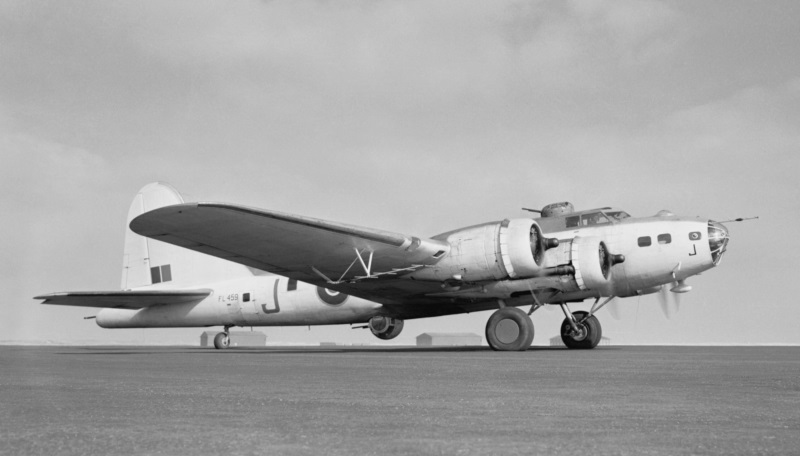
One B-17E ended up in British hands as the personal transport of General Bernard Law Montgomery. During the campaign in North Africa, Montgomery bet General Dwight D. Eisenhower that he would capture Sfax in Tunisia by 15 April 1943. He won the bet, and Eisenhower provided him with a B-17E. Officially, this B-17E remained on the books with the USAAF. It retained most of its armament and had few comforts. Montgomery exchanged it for a more comfortable Douglas C-47 Dakota when one became available.
BACK_TO_TOP